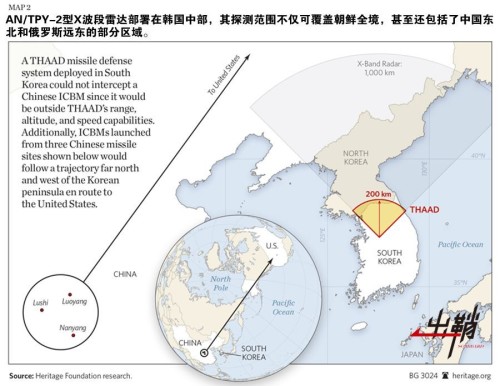Despite repeated opposition by China, the US and South Korea have finally agreed to deploy the THAAD missile defense system on the soil of South Korea. It is a long-planned and well-calculated move by the US, whose openly declared objective is to counter the “nuclear and missile threat from North Korea”, but the real target of THAAD in East Asia is obviously China, even though both the US and South Korea deny it vigorously.

Why is the THAAD deployment strongly opposed by China? Let us take a look at consequential scenarios of THAAD deployment in East Asia.
Firstly, it will undermine regional strategic balance and create more obstacles to peaceful settlement of the Korean Peninsula nuclear issue.
The security of any region is based on a strategic balance that maintains security order and prevents conflicts. When that balance is broken, the ensuing security disorder and chaos will stimulate an arms race and sharpen regional disputes and conflicts. A steep price has to be paid before such balance is restored again.
The Korean Peninsula is one of the few places that war status still prevails, and there could be recurrence of war at any time should something go wrong. The Peninsula has also witnessed a nuclear crisis on and off for over a decade and negotiations, including “the Six-Party Talks”, to settle the issue have been stalled for some years.
In such a sensitive and crisis-ridden region, THAAD deployment could tip the delicate balance, opening the door to a dangerous path to military confrontation.
There are two ways to rectify the current strategic imbalance. One is for the US and ROK to rescind the deployment on their own and thus untie the knot they have created in the first place. If that is not done, the second option will be for China, whose strategic interests are threatened by THAAD, to strengthen its offensive nuclear capability so as to restore strategic balance ante.
Once THAAD is in place, major parts of China will obviously be under its radar coverage and anti-missile system umbrella. Faced with such a threat to its nuclear deterrence capability, can China sit tight and do nothing about it?
Secondly, the deployment of THAAD in South Korea is part and parcel of the US missile defense system in East Asia, a region of strategic importance to the US where China is viewed as a possible hegemon that will challenge the American “DLP” (Dominance, Leadership and Primacy). Therefore China has been singled out by the US as the target for “off-shore balancing” in the region. THAAD as part of East Asia missile defense system is an indispensible component of that “balance” or “rebalance”.
Professors John J. Mearsheimer from the University of Chicago and Stephen M. Walt from Harvard University recently published an article in “Foreign Affairs” outlining “off-shore balancing” as a superior Grand Strategy to be applied seriously by the US in East Asia and Europe. These two neo-con theorists have unmistakably identified China as “likely to seek hegemony in Asia” and call on the US to undertake a major effort “to prevent it from succeeding”. What “off-shore balancing” calls for in East Asia is first to “rely on local powers to contain China”. Should that fail, the US may “have to throw its considerable weight behind them”.
THAAD is certainly a case in point. The American direct involvement in the South China Sea issue, by supporting the Philippines in its political farce of seeking “international arbitration” and the show of force by American Navy and Air Force, is another example of its “off-shore balancing” and “Asia-Pacific Rebalance” strategy being put into practice in East Asia.
Though the US has been in strategic entrenchment mode since President Obama entered office in early 2009, the retrenchment actually serves its “off-shore balancing” in East Asia quite well by concentrating its military assets in this region as well as supporting its allies Japan, the Philippines in their sovereign and maritime disputes with China.
The US is used to thinking and acting as a hegemonic power, as if the world is created for it alone. However, we live in an era of globalization wherein nations become more interdependent and connected with one another. No nation can be “balanced” away as the US wishes.
Not long ago, China and Russia issued a joint statement for the maintenance of global stability, mentioning in particular that the deployment of missile defense systems in Eastern Europe and East Asia will undercut global stability or global equilibrium.
Lastly, THAAD deployment will worsen the bifurcation in East Asia, where regional arrangements for economic growth are shaped with China at its core while regional security architecture is set up with the US-centered military alliances as its foundation. Should this contradictory situation further develop, neither regional economic growth nor security could be sustained.
Take the ROK for example. Its trade with China accounts for a quarter of its total external trade, and China is the most important source of ROK’s tourism. When THAAD become a reality, can one expect the close economic relationship between the two countries to remain intact?
In sum, deployment of THAAD is detrimental to the regional security of East Asia. No nation can expect to achieve absolute security at the expense of other nations’ insecurity. East Asia should enjoy peace and stability based on common and cooperative security in the region. It is strongly advised that those countries involved need to seriously reconsider their ill-conceived decisions, so that regional strategic balance can be restored soon.


